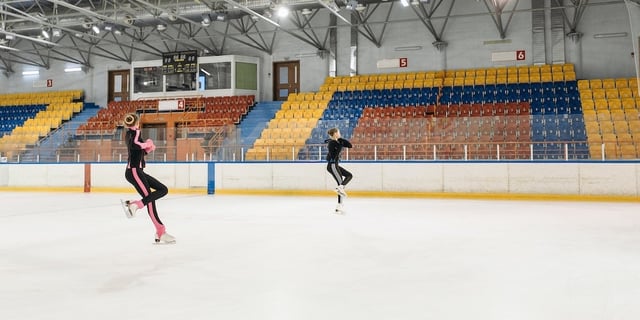Draw your Agile lessons from the right sport: Synchronized skating

Using sports metaphors is a bit cliché, but they tend to be easy to understand. And you can learn a lot about building Scrum teams from the comparison because there are a lot of similarities.
The problem is: many get their metaphors from the wrong sports!
They stick with football (which most people are familiar with) or even rugby (where the term “Scrum” originally comes from).
But here’s the catch:
Scrum is not football or rugby — it is synchronized skating
It’s not about scoring a goal. Your team is supposed to create value for someone. Therefore, if you are simply concentrating on who is winning, you are missing the opportunity to create something extraordinary.
So I would rather introduce a more suitable metaphor here, closer to performing arts: synchronized skating, which I just happen to have experience with.
What is synchronized skating?
In case you are not familiar with it, synchronized skating is a sport where a group of skaters together perform a routine on ice. This takes deep collaboration and coordination among team members. Have a look at the video below, and you’ll know what I’m talking about.
Imagine what it takes to build a program—another handy metaphor there—with the whole team. How to make it look effortless, and at the same time create an emotional experience that everyone in the audience will remember.
Your Scrum team operates in a market, which is also a competition. But it takes much more than a simple set of technical skills to win it. Your team can only deliver if they work seamlessly together as a team. The chain only is as strong as its weakest link.
So let’s learn from something as complex as synchronized skating, and extract valuable lessons to build a strong Agile team (no skating lessons required).
The two unique Scrum-team-building lessons from synchronized skating
1. Don’t ignore someone who is not contributing
There can be many reasons why they’re not contributing. Yes, they may still lack the necessary technical skills, but it can just as easily be that your most talented team member is more interested in showing off than providing the necessary value to others.
Despite the different skills, you simply can’t afford to have individual stars in your team. Divas mainly want to promote themselves, not your product.
I have seen teams with superb technical skills lose just because they have been unable to build an engaging performance as a team.
I have also seen other teams win over the audience, and win the competition because they have been more creative, passionate, and determined as a team.
That has made all the difference, and that’s when the whole does indeed become greater than the sum of its parts.
2. Make sure you set the right goals
Make no mistake, to achieve what I mentioned above, you really need to set your goal first. And it has to be a goal that you can only achieve—you guessed it—as a team. Something that every individual is committed to, as a part of a group.
The goal also has to be:
- so concrete that everyone without a doubt understands it the same way
- inspiring enough for all of the team members to be willing to work toward it
In the world of sports, defining the goal is often quite easy. Let’s say the dream is that the team will be in the top 5 in the World Championships in two years.
For work, forming a common goal is often more complicated. But once in place, it makes everything after it easier.
- You can build your team’s strategy with the ultimate target in mind
- You can define subgoals in a way that makes it crystal clear if you are heading in the right direction, and estimate if achieving your goal is still realistic.
What's more, you will be able to trust that your colleagues are also doing their best to reach the same end, even when you disagree with them about the details from time to time.
Easy enough, right?
Well, far from it, of course. Reality is more complex than the metaphor. But we need the metaphors—it’s impossible not to.
But be mindful of choosing yours. If you just happily accept without any questions the comparison made by someone else, chances are that you haven’t really thought it through: what it actually stands for, and if it makes sense to you on a more detailed level.
To sum it up, when thinking about your Scrum team, you can learn at least the following from a synchronized skating team:
- Your team will become something greater than the sum of its parts and reach its full potential when you succeed in working as a committed unit toward a common goal
- You do need technical skills, but they are not the determining factor if you are lacking in other areas, such as creativity, enthusiasm, and teamwork
- The audience will love you if you manage to surprise them and perform in a way that evokes strong positive emotions in them—remembering this might be the most important thing.
Published:
Updated:


